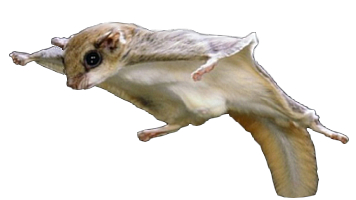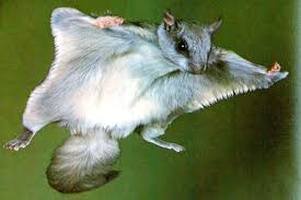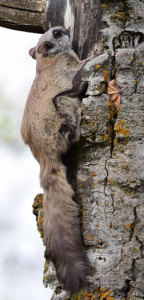 Northern flying squirrels are found in the boreal forest of central Alberta, and in the river valley of Edmonton. They are common, but are rarely seen because, unlike most squirrels, they are nocturnal.
These flying squirrels are small tree squirrels; they're light brown with pale underparts. They are
excellent gliders and climbers, but clumsy on the ground. Their diet consists of
fungi, nuts, tree sap, insects, carrion, bird eggs, buds, and flowers.
Northern flying squirrels are found in the boreal forest of central Alberta, and in the river valley of Edmonton. They are common, but are rarely seen because, unlike most squirrels, they are nocturnal.
These flying squirrels are small tree squirrels; they're light brown with pale underparts. They are
excellent gliders and climbers, but clumsy on the ground. Their diet consists of
fungi, nuts, tree sap, insects, carrion, bird eggs, buds, and flowers.
Northern flying squirrels inhabit forested areas, especially coniferous forests. They will make nests in dead trees, underground hollows, and tree branches. Occasionally, they may find their way into human structures. These squirrels don't hibernate in the winter. They remain active, although they may congregate in nests of nearly a dozen individuals to conserve body heat in the coldest parts of winter.  Flying squirrels don't actually fly, rather they glide using a membrane created by a fold of skin. Flying squirrels can glide from a running start along a high tree branch, or from a stationary position by bringing their limbs under their body, retracting their heads, and then propelling themselves off the tree. They can reach distances of up to 45 metres or more.
Flying squirrels don't actually fly, rather they glide using a membrane created by a fold of skin. Flying squirrels can glide from a running start along a high tree branch, or from a stationary position by bringing their limbs under their body, retracting their heads, and then propelling themselves off the tree. They can reach distances of up to 45 metres or more.It is believed that they use triangulation to estimate the distance of the landing, as they often lean out and pivot from side to side before jumping. Once in the air, they form an "X" with their limbs, causing their membrane to stretch into a square-like shape, and they glide down at angles of 30 to 40 degrees.  They can maneuver very efficiently, making 90 degree turns around obstacles if needed. Just before reaching another tree they raise their flattened tails, which changes their trajectory upwards, and point all of their limbs forward to create a parachute effect with the membrane to reduce the shock of landing. Their limbs absorb the impact, and the squirrel immediately runs to the other side of the trunk or to the top of the tree to avoid any potential predators.
They can maneuver very efficiently, making 90 degree turns around obstacles if needed. Just before reaching another tree they raise their flattened tails, which changes their trajectory upwards, and point all of their limbs forward to create a parachute effect with the membrane to reduce the shock of landing. Their limbs absorb the impact, and the squirrel immediately runs to the other side of the trunk or to the top of the tree to avoid any potential predators.
Northern flying squirrels' large ears and huge, black eyes enable them to navigate easily at night; this and their gliding means they are often mistaken for bats. They are a primary prey species for a variety of owls. Other predators include hawks, martens, lynx, and foxes. |